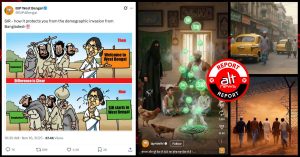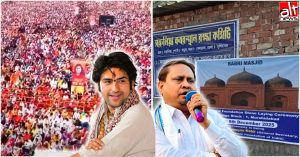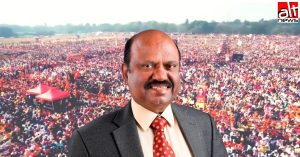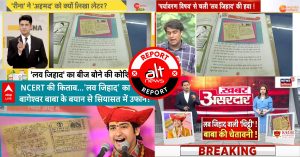On March 17, 2025, violence erupted in Nagpur, Maharashtra, after claims began circulating that a piece of cloth with a verse from the Quran inscribed on it was burnt during a protest led by Hindutva outfits. The demonstration involved Mughal emperor Aurangzeb’s effigy being burnt. As tensions escalated, violent clashes broke out, resulting in injuries to approximately 30 people. The unrest also led to large-scale vandalism in which houses were attacked and vehicles torched.
Absurd as it may sound, the figure of Aurangzeb, the Mughal emperor who ruled over 300 years ago, continues to be a subject of political controversy in India, particularly in Maharashtra. Various Right-wing groups and sections of mainstream media have frequently propped up the issue, making it a recurring point of political and communal debate. A few months before the Nagpur violence, Prime Minister Narendra Modi, during a public address in Chhatrapati Sambhaji Nagar, Maharashtra, criticised Congress over its stance on historical figures. In his speech, Modi accused the Congress of opposing the legacy of Chhatrapati Sambhaji Maharaj while glorifying Aurangzeb, stating that such actions went against Maharashtra’s pride and the identity of Marathi heritage.
The latest controversy surrounding Aurangzeb and the subsequent violence in Nagpur are closely linked to the release of the film Chhaava, which portrays the life of Chhatrapati Sambhaji Maharaj and depicts the brutal torture inflicted on him by Aurangzeb. The film released on February 14, 2025, and received a U/A 16+ certification from the Central Board of Film Certification (CBFC). This certification indicates that while the film is unrestricted for public viewing, parental guidance is advised for children under 16 years. The depiction of Aurangzeb as a tyrant and the gruesome execution of Sambhaji Maharaj stirred intense emotions among the audience, particularly in Maharashtra. Several viral videos emerged from cinema halls, capturing audiences chanting slogans, some of whom were children.
The graphic portrayal of Aurangzeb’s cruelty appeared to have heightened Maratha pride, leading to emotional outbursts among viewers. Many individuals were seen in tears, expressing their anguish in reviews and social media posts. The film’s impact was not limited to Maharashtra, as communal sentiments flared in different parts of India. Some instances were also reported where viewers, enraged by the film, tore the screens in theatres.
A number of Hindutva leaders and BJP members promoted the film Chhaava. A public screening of the film was sponsored by Pandit Dhirendra Shastri’s Bageshwar Dham. Prime Minister Modi also praised the film while speaking at the 98th All India Marathi Sahitya Sammelan in New Delhi, recently.
Who Said What Before the Violence
On March 3, 2025, Samajwadi Party (SP) MLA Abu Azmi made a statement in the Maharashtra assembly, arguing that Aurangzeb should be viewed as an administrator rather than a cruel ruler. Azmi stated that the conflict between Chhatrapati Shivaji Maharaj and Aurangzeb was primarily a struggle for power rather than a religious or communal rivalry. He further praised the Mughal era, claiming that India had progressed significantly under the rule of both Shivaji and Aurangzeb. His remarks sparked outrage in the Maharashtra assembly, leading to protests for two days. Following the uproar, Azmi was suspended for the remainder of the budget session for his remarks on Aurangzeb.
The release of the film Chhaava had already intensified discussions around Aurangzeb. In this politically and emotionally charged atmosphere, Abu Azmi’s remarks became a political flashpoint, drawing reactions from Maharashtra to Uttar Pradesh. Uttar Pradesh chief minister Yogi Adityanath made a scathing attack on the Samajwadi Party, demanding that Abu Azmi be expelled from the party. Yogi Adityanath further stated, “Send him to Uttar Pradesh, we will deal with him.” Following Azmi’s statement, protests began at various places across Maharashtra. BJP leaders, along with Hindutva organizations like Bajrang Dal and Vishwa Hindu Parishad, started demanding the demolition of Aurangzeb’s tomb, saying that he had tortured Hindus and preserving Aurangzeb’s tomb was a glorification of one of the most tyrannical rulers in Indian history.
Activists from various Hindu organisations staged demonstrations across Maharashtra and handed over memorandums to local authorities demanding its removal. At several places, the protesters also used hammers to destroy a demo model of the tomb. Bajrang Dal and Vishva Hindu Parishad also intensified their demand to remove the tomb of Mughal emperor Aurangzeb and threatened to do ‘kar seva’ if the government failed to take action. In a press conference in Pune, Vishva Hindu Parishad’s Kishore Chavan called Aurangzeb’s tomb a symbol of betrayal, hatred and oppression of Hindus.
Instead of making an appeal to uphold peace and social harmony, the ruling Bharatiya Janata Party and those in power in the Maharashtra government supported the demand for action to demolish Aurangzeb’s tomb, which boosted the morale of the protesters and encouraged them to intensify their demonstrations.
BJP leader and former MP Navneet Rana demanded the removal of Aurangzeb’s tomb from Maharashtra. He talked about uprooting Aurangzeb’s grave and stated that those who loved Aurangzeb should decorate his grave in their homes.
BJP MP from Satara Udayanraje Bhosale questioned the need for a grave and demanded a JCB excavator machine demolish it. Reacting to this, Maharashtra chief minister Devendra Fadnavis supported Bhosale and said that he also wanted the same, although he added that the grave was a protected monument under the Archaeological Survey of India (ASI) and it could be removed only through legal means.
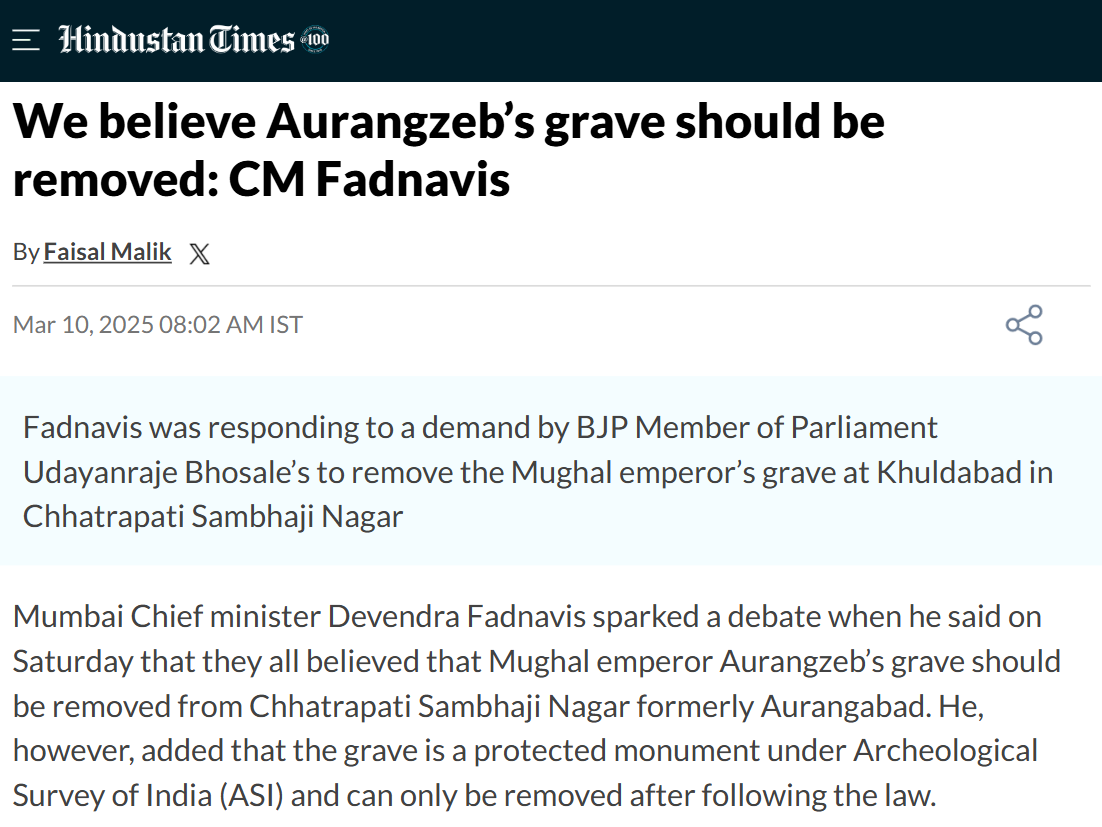
Nitesh Rane, a minister in the Maharashtra government and a BJP leader who often makes controversial statements, made an inflammatory statement in a speech in Ratnagiri, Maharashtra. He stated, “Journalists keep thinking that I will remove Aurangzeb’s tomb. I will not tell you when I will remove it. Just like I deal with encroachments, first we tear them down and then it becomes breaking news.” In the same speech, Rane made a communal comment and said that those who liked Aurangzeb should go to their father’s land, Pakistan. During another speech in Pune, citing the Babri demolition, he supported the demand to demolish Aurangzeb’s tomb, remarking, “The government will do its work, while Hindutva organizations continue doing theirs. When the Babri Masjid was being demolished, we were not sitting and talking to each other. Our kar sevaks did what was right.”
In a programme organized by the Vishva Hindu Parishad and the Bajrang Dal in Pune, a supporter of BJP MLA T Raja Singh tore Aurangzeb’s picture. Then, in a virtually open call for violence, Raja Singh said that just like the poster was torn down, Aurangzeb’s supporters would also be torn apart. Raja Singh further stated that now they would not stop, and create history. He added that the Hindus of India would always remember whoever destroyed Aurangzeb’s grave from the soil of Maharashtra. He also made some inflammatory comments, stating that just like they destroyed Babri Masjid, they would find a way to destroy Aurangzeb’s tomb.
Similarly, Maharashtra deputy chief minister Eknath Shinde said in a statement to the media that no one would tolerate Aurangzeb’s supporters and he justified the people agitating for Aurangzeb at various places, remarking that he was very serious about Sambhaji Maharaj.
BJP leader Ram Kadam also demanded the removal of Aurangzeb’s tomb and stated that he was on the side of those speaking about removing the tomb. In Muzaffarnagar, Uttar Pradesh, Shiv Sena workers announced a reward of 5 bighas of land and Rs. 11 lakh to any individual who demolished Aurangzeb’s tomb.
Numerous Hindutva organizations and leaders of the ruling party BJP have made inflammatory statements about Aurangzeb’s legacy. The language used in these speeches presented historical grievances as ongoing political issues.
The Aurangzeb controversy sparked by the film Chhaava and its impact on public sentiment reflects deep social tensions in India about historical narratives being used as fuel to promote hatred in politics and incite communal tensions in society. The portrayal of Aurangzeb in the film is being used as an opportunity for Hindutva groups to air out their views on historical injustice while garnering support among the majority community. This situation shows how historical trauma, combined with political agenda, can incite violence in society.
Amid growing threats against Aurangzeb’s tomb in Maharashtra following inflammatory speeches and demands for the removal of the tomb by several Hindutva and right-wing organisations, the administration has tightened security arrangements at the site. Local police officials have been deployed at various points around the area. Several security checkpoints have been set up on the route from the city to the tomb for surveillance and security. Authorities have made it mandatory for visitors to Aurangzeb’s tomb to register their names and provide identity documents.
It seems quite bizzarre that on one hand the ministers in the government including the chief minister and the leaders of the ruling party are inciting or supporting people to destroy Aurangzeb’s tomb, while on the other hand the same chief minister, Devendra Fadnavis, was assuring that security has been increased around Aurangzeb’s tomb and any kind of demolition attempts will be stopped. Till now, no complaint has been filed against any leader or minister for calling for the destruction of the tomb.
Independent journalism that speaks truth to power and is free of corporate and political control is possible only when people start contributing towards the same. Please consider donating towards this endeavour to fight fake news and misinformation.
